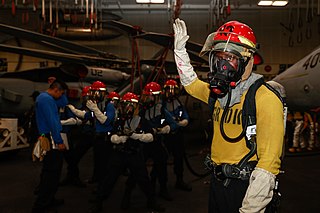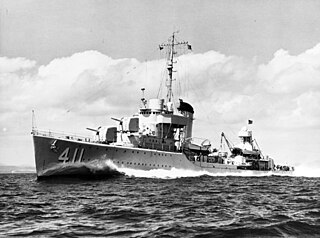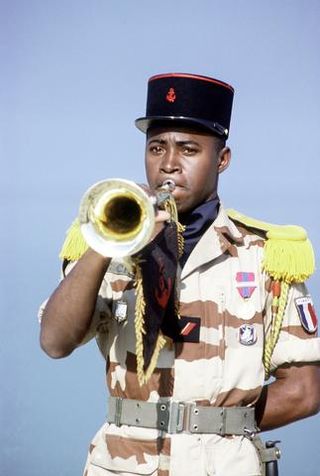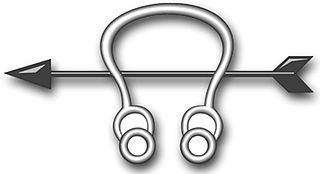
USS Underhill (DE-682) was a Buckley-class destroyer escort of the United States Navy during World War II. Built in 1943, she served in the Atlantic, the Mediterranean, and the Pacific until her sinking in a suicide attack by a Japanese Kaiten manned torpedo on 24 July 1945.

USS Wasp (CV-7) was a United States Navy aircraft carrier commissioned in 1940 and lost in action in 1942. She was the eighth ship named USS Wasp, and the sole ship of a class built to use up the remaining tonnage allowed to the U.S. for aircraft carriers under the treaties of the time. As a reduced-size version of the Yorktown-class aircraft carrier hull, Wasp was more vulnerable than other United States aircraft carriers available at the opening of hostilities. Wasp was initially employed in the Atlantic campaign, where Axis naval forces were perceived as less capable of inflicting decisive damage. After supporting the occupation of Iceland in 1941, Wasp joined the British Home Fleet in April 1942 and twice ferried British fighter aircraft to Malta.

USS Forrestal (CVA-59), was a supercarrier named after the first United States Secretary of Defense James Forrestal. Commissioned in 1955, she was the United States' first completed supercarrier, and was the lead ship of her class. The other carriers of her class were USS Saratoga, USS Ranger and USS Independence. She surpassed the World War II Japanese carrier Shinano as the largest carrier yet built, and was the first designed to support jet aircraft.

USS America (CVA/CV-66) was one of three Kitty Hawk-class supercarriers built for the United States Navy in the 1960s. Commissioned in 1965, she spent most of her career in the Atlantic and Mediterranean, but did make three Pacific deployments serving in the Vietnam War. She also served in the Persian Gulf War's operations Desert Shield and Desert Storm.

USS Tunny (SS/SSG/APSS/LPSS-282) was a Gato-class submarine which saw service in World War II and in the Vietnam War. Tunny received nine battle stars and two Presidential Unit Citations for her World War II service and five battle stars for her operations during the Vietnam War. Tunny was the first ship of the United States Navy to be named for the tunny, any of several oceanic fishes resembling the mackerel.

Tench-class submarines were a type of submarine built for the United States Navy (USN) between 1944 and 1951. They were an improvement over the Gato and Balao classes, only about 35 to 40 tons larger, but more strongly built and with a slightly improved internal layout. One of the ballast tanks was converted to carry fuel, increasing range from 11,000 nautical miles to 16,000 nautical miles. This improvement was also made on some boats of the previous two classes. Further improvements were made beginning with SS-435, which are sometimes referred to as the Corsair class. Initial plans called for 80 to be built, but 51 were cancelled in 1944 and 1945 when it became apparent that they would not be needed to defeat Japan. The remaining 29 were commissioned between October 1944 (Tench) and February 1951 (Grenadier). The last submarine of the Tench class, as well as the last submarine which served during World War II, remaining in service with the U.S. Navy was USS Tigrone (AGSS-419) which was decommissioned on 27 June 1975.

USS Barry (DD-933) was one of eighteen Forrest Sherman-class destroyers of the United States Navy, and was the third US destroyer to be named for Commodore John Barry. Commissioned in 1954, she spent most of her career in the Caribbean, Atlantic, and Mediterranean, but also served in the Vietnam War, for which she earned two battle stars. Another notable aspect of her service was the Cuban Missile Crisis in 1962.

General quarters, battle stations, or action stations is an announcement made aboard a naval warship to signal that all hands aboard a ship must go to battle stations as quickly as possible.

USS Wake Island (CVE-65) was a Casablanca-class escort carrier of the United States Navy.
The Submarine Warfare Insignia are worn by qualified submariners.

USS Anderson (DD-411) was a Sims-class destroyer in the United States Navy. She was named for Rear Admiral Edwin Alexander Anderson, Jr., a Medal of Honor recipient.

A bugle call is a short tune, originating as a military signal announcing scheduled and certain non-scheduled events on a military installation, battlefield, or ship. Historically, bugles, drums, and other loud musical instruments were used for clear communication in the noise and confusion of a battlefield. Naval bugle calls were also used to command the crew of many warships.

A fire alarm control panel (FACP), fire alarm control unit (FACU), fire indicator panel (FIP), or simply fire alarm panel is the controlling component of a fire alarm system. The panel receives information from devices designed to detect and report fires, monitors their operational integrity, and provides for automatic control of equipment, and transmission of information necessary to prepare the facility for fire based on a predetermined sequence. The panel may also supply electrical energy to operate any associated initiating device, notification appliance, control, transmitter, or relay. There are four basic types of panels: coded panels, conventional panels, addressable panels, and multiplex systems.
An officer of the deck (OOD) underway is a watchstanding duty officer on a surface ship in the United States Navy, United States Coast Guard, and NOAA Commissioned Officer Corps who is tasked with certain duties and responsibilities for the ship. The officer of the deck is either subordinate to the command duty officer or, in the absence of one, reports directly to the ship's commanding officer and executive officer, in the latter case holding responsibility for the ship altogether. This article describes duties and responsibilities for an underway OOD for surface ships only.

USS Bebas (DE-10) was an Evarts-class destroyer escort in the service of the United States Navy from 1943 to 1945.

Sonar technician is a United States Navy occupational rating.
A command duty officer or officer of the watch is the head duty officer on a ship, entrusted by the commanding officer and executive officer or the shipmaster with exercising in their absence command and control of the ship on their behalf for the duration of a watch.

On 29 July 1967, a fire broke out on board the aircraft carrier USS Forrestal after an electrical anomaly caused a Zuni rocket on an F-4B Phantom to fire, striking an external fuel tank of an A-4 Skyhawk. The flammable jet fuel spilled across the flight deck, ignited, and triggered a chain reaction of explosions that killed 134 sailors and injured 161. At the time, Forrestal was engaged in combat operations in the Gulf of Tonkin, during the Vietnam War. The ship survived, but with damage exceeding US$72 million, not including the damage to aircraft. Future United States Senator John McCain and future four-star admiral and U.S. Pacific Fleet Commander Ronald J. Zlatoper were among the survivors. Another on-board officer, Lieutenant Tom Treanore, later returned to the ship as her commander and retired an admiral.

The 1966 USS Oriskany fire was a major fire that broke out aboard the Essex-class aircraft carrier USS Oriskany on the morning of 26 October 1966. The fire broke out after a lit flare was locked in a flare locker. The fire killed 44 people, mostly air crew, and injured 156 more. It was the first of three major fires to befall American carriers during the Vietnam War.

















